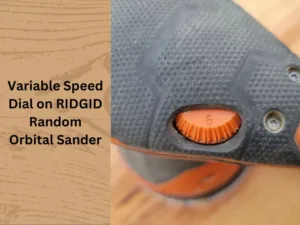
Whether you are brand new to woodworking or are a seasoned pro, there is a question you are likely to run into when selecting a random orbital sander for your shop.
“What’s the difference between a variable and fixed speed random orbital sander?” or “Do I even need a variable speed random orbital sander?”.
To answer these questions, we can first start by defining the difference between the two types of orbital sanders.
The difference between a variable speed and fixed speed random orbital sander is the ability to adjust the OPMs (Orbits Per Minute). A fixed-speed random orbital sander is set at a fixed OPM of anywhere from 10,000 to 12,000 OPMs depending on the manufacturer. Likewise, a variable speed random orbital sander can adjust the OPMs ranging anywhere from 7,000 – 12,000 OPMs.
The difference between the two types of orbital sanders is a very clean-cut answer. However, determining if you need one or the other takes a bit more information.
Sanding Speed: More Than Just a Dial
Sanding speed in the context of the OPMs can be either variable or fixed. However, there is another speed adjustment to consider. The rate at which you move the sander.
As you change the speed of the sander across the workpiece, you are affecting the sanding speed. Let’s look at this with an example to help illustrate what I mean.

Let’s say you have two random orbital sanders, Sander 1 which operates at 5,000 OPM while Sander 2 operates at double that speed at 10,000 OPM. If you hold Sander 2 at one spot for 1 full minute, it will have made 10,000 orbits (hence 10,000 Orbits Per Minute). If you hold Sander 1 at the same spot for 1 full minute, it will have made only 5,000 orbits. But, if you hold Sander 1 at the same spot for 2 full minutes it will have made 5,000 orbits the first minute and 5,000 orbits the second minute, totaling 10,000 total orbits.
What this goes to show is that fundamentally the different speed sanders can do the same amount of work, it just may come down to how fast you move the sander across the workpiece.
At 12,000 OPM the recommended travel speed for sanding is 1 inch per second. This travel time is more of a suggestion but will need to be adjusted depending on the OPM that your random orbital sander is operating at.
Slower Speed on Sander, When is it Useful?
After seeing the example play out in the previous section, you are probably really wondering why anyone would ever need the variable speed option. Can’t you just change the speed that you move the sander? Yes you can do that but it is not always ideal.
Let’s dig into some areas where a variable speed orbital sander can be useful.
- Delicate areas. You have to be careful sanding on delicate areas such as around corners or edges. This is where it can be helpful to slow the sander down. Slowing down the OPM can help prevent taking off too much material on these spots.
- Paint/Finish. If you are sanding over a finish or painted surface, going slower is recommended. As paint gets hot it can cause issues with your sanding disc getting clogged.
- Risk of going through the surface. Sanding on thin items such as veneers can pose a risk of actually sanding through the workpiece. To help reduce this risk, you can turn down the speed of the sander.

Just a note that needs to be said, is running your random orbital sander at a slower speed can have negative consequences. The slower you go, if you do not compensate with your travel speed, can cause pigtails to start to appear.
Is a Variable Speed Random Orbital Sander More Expensive?
Yes, adding the variable speed option does add cost to the total price of the product. However, this cost is minimal. It adds a few bucks but the versatility you will gain from adding the option is worth it in my opinion.
For comparison, if you look at the Dewalt corded variable speed random orbital sander at the time of this article, the price comes in at $89. In comparison, if you look at a very similar Dewalt model that does not have the variable speed option, it is $74 at the time of writing. For an extra $15 you get a lot of versatility of your sander, allowing you to be prepared no matter what project you take on.
Conclusion
Purchasing a variable-speed random orbital sander is a great option, mainly for the versatility you gain. With the flip of a switch, you can adjust your sander to better suit your sanding needs, whatever they may be.
However, it is not a necessary option. In most use cases, your sander will stay on one speed and you will never even have to change it.
There is generally not a large difference in the price of the two options, so if you can afford the few extra bucks for the variable speed sander, that is the route we recommend going with.


